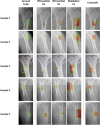Detection of incomplete atypical femoral fracture on anteroposterior radiographs via explainable artificial intelligence
- PMID: 37369833
- PMCID: PMC10300092
- DOI: 10.1038/s41598-023-37560-9
Detection of incomplete atypical femoral fracture on anteroposterior radiographs via explainable artificial intelligence
Abstract
One of the key aspects of the diagnosis and treatment of atypical femoral fractures is the early detection of incomplete fractures and the prevention of their progression to complete fractures. However, an incomplete atypical femoral fracture can be misdiagnosed as a normal lesion by both primary care physicians and orthopedic surgeons; expert consultation is needed for accurate diagnosis. To overcome this limitation, we developed a transfer learning-based ensemble model to detect and localize fractures. A total of 1050 radiographs, including 100 incomplete fractures, were preprocessed by applying a Sobel filter. Six models (EfficientNet B5, B6, B7, DenseNet 121, MobileNet V1, and V2) were selected for transfer learning. We then composed two ensemble models; the first was based on the three models having the highest accuracy, and the second was based on the five models having the highest accuracy. The area under the curve (AUC) of the case that used the three most accurate models was the highest at 0.998. This study demonstrates that an ensemble of transfer-learning-based models can accurately classify and detect fractures, even in an imbalanced dataset. This artificial intelligence (AI)-assisted diagnostic application could support decision-making and reduce the workload of clinicians with its high speed and accuracy.
© 2023. The Author(s).
Conflict of interest statement
No conflict of interest exits in the submission of this manuscript, and manuscript is approved by all authors for publication.
Figures







References
-
- Kim T, et al. Virtual surface morphology generation of Ti-6Al-4V directed energy deposition via conditional generative adversarial network. Virtual Phys. Prototyp. 2023;18:e2124921. doi: 10.1080/17452759.2022.2124921. - DOI
-
- Seo E, et al. Laser powder bed fusion for AI assisted digital metal components. Virtual Phys. Prototyp. 2022;17:806–820. doi: 10.1080/17452759.2022.2068804. - DOI
-
- Bak T, et al. Accelerated design of high-efficiency lead-free tin perovskite solar cells via machine learning. Int. J. Precis. Eng. Manuf. Green Technol. 2023;10:109–121. doi: 10.1007/s40684-022-00417-z. - DOI
Publication types
MeSH terms
LinkOut - more resources
Full Text Sources
Medical

